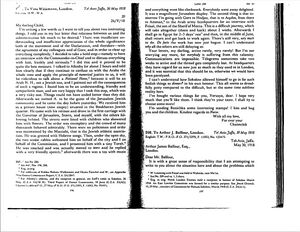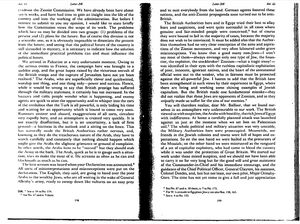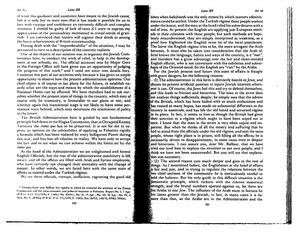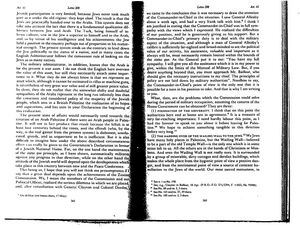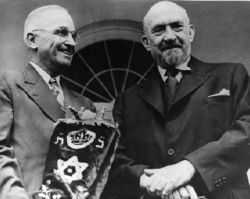حاييم وايزمان
Chaim Weizmann | |
|---|---|
חיים ויצמן | |
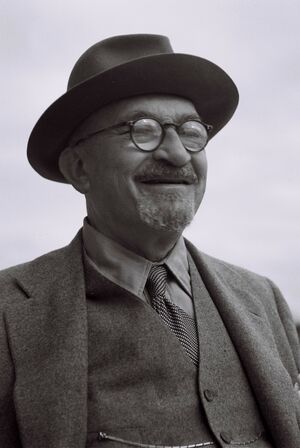 Weizmann in 1949 | |
| 1st President of Israel | |
| في المنصب 17 February 1949 – 9 November 1952 | |
| رئيس الوزراء | David Ben-Gurion |
| سبقه | Himself (as Chairman of the Provisional State Council) |
| خلـَفه | Yitzhak Ben-Zvi |
| 2nd Chairman of the Provisional State Council of Israel | |
| في المنصب 16 May 1948 – 17 February 1949 | |
| رئيس الوزراء | David Ben-Gurion |
| سبقه | David Ben-Gurion |
| خلـَفه | Himself (as President) |
| تفاصيل شخصية | |
| وُلِد | Chaim Azriel Weizmann 27 نوفمبر 1874 Motal, Grodno Governorate, Russian Empire |
| توفي | 9 نوفمبر 1952 (aged 77) Rehovot, Israel |
| الجنسية | Russian Empire United Kingdom Israel |
| الحزب | General Zionists |
| الزوج | Vera Weizmann |
| القرابة | Maria Weizmann (sister) Anna Weizmann (sister) Minna Weizmann (sister) Ezer Weizman (nephew) |
| الأنجال | 2 |
| المدرسة الأم | Technical University of Darmstadt Technical University of Berlin University of Fribourg |
| المهنة | Biochemist |
| مبعث الشهرة | Politics: helped establish the State of Israel. Science: industrial fermentation, acetone–butanol–ethanol fermentation process, critical to the WWI Allied war effort. Founder of the Sieff Research Institute (now Weizmann Institute), helped establish the Hebrew University of Jerusalem. |
| التوقيع | |
حاييم وايزمان (بالعبرية: חיים ויצמן) (27 نوفمبر 1874 - 9 نوفمبر 1952) اشهر شخصية صهيونية بعد هرتزل. لعب الدور الاهم في استصدار وعد بلفور نوفمبر 1917. كان رئيسا للمنظمة الصهيونية العالمية منذ عام1920 حتى عام 1946 ثم انتخب رئيسا للدولة العبرية 1949.
As a biochemist, Weizmann is considered to be the 'father' of industrial fermentation. He developed the acetone–butanol–ethanol fermentation process, which produces acetone, n-butanol and ethanol through bacterial fermentation. His acetone production method was of great importance in the manufacture of cordite explosive propellants for the British war industry during World War I. He founded the Sieff Research Institute in Rehovot (later renamed the Weizmann Institute of Science in his honor), and was instrumental in the establishment of the Hebrew University of Jerusalem.
يعد حاييم وايزمان أشهر الشخصيات الصهيونية بعد هرتزل، وقد لعب الدور الأهم في استصدار و عد بلفور الشهير عام 1917, وكان رئيسا للمنظمة الصهيونية العالمية منذ عام 1920 حتى عام 1946, ثم انتخب كأول رئيس لدولة إسرائيل عام 1949.
. . . . . . . . . . . . . . . . . . . . . . . . . . . . . . . . . . . . . . . . . . . . . . . . . . . . . . . . . . . . . . . . . . . . . . . . . . . . . . . . . . . . . . . . . . . . . . . . . . . . . . . . . . . . . . . . . . . . . . . . . . . . . . . . . . . . . . . . . . . . . . . . . . . . . . . . . . . . . . . . . . . . . . . .
السيرة
ولد حاييم وايزمان في بلدة موتول في ولاية "بنسك" إحدى ولايات روسيا البيضاء عام 1874. كان والده من وجهاء موتول المتدينين وكان يعمل تاجرا للأخشاب يقوم بتقطيعها من الغابات ثم ينقلها بعد ذلك إلى الموانئ الروسية لتصديرها.
Chaim Weizmann was born in the village of Motal, located in what is now Belarus and at that time was part of the Russian Empire in 1874. He was the third of 15 children born to Oizer and Rachel (Czemerinsky) Weizmann.[1] His father was a timber merchant.[2] From ages four to eleven, he attended a traditional cheder, or Jewish religious primary school, where he also studied Hebrew. At the age of 11, he entered high school in Pinsk, where he displayed a talent for science, especially chemistry. While in Pinsk, he became active in the Hovevei Zion movement. He graduated with honors in 1892.[3][4]
In 1892, Weizmann left for Germany to study chemistry at the Polytechnic Institute of Darmstadt. To earn a living, he worked as a Hebrew teacher at an Orthodox Jewish boarding school.[5] In 1894, he moved to Berlin to study at the Technische Hochschule Berlin.
While in Berlin, he joined a circle of Zionist intellectuals.[4] In 1897, he moved to Switzerland to complete his studies at the University of Fribourg. In 1898, he attended the Second Zionist Congress in Basel. That year he became engaged to Sophia Getzowa.[6] Getzowa and Weizmann were together for four years before Weizmann, who became romantically involved with Vera Khatzman in 1900, confessed to Getzowa that he was seeing another woman. He did not tell the family he was leaving Getzowa until 1903.[6] His fellow students held a mock trial and ruled that Weitzman should uphold his commitment and marry Getzowa, even if he later divorced her. Weizmann ignored their advice.[7]
Of Weizmann's fifteen siblings, ten immigrated to Palestine.[3] Two also became chemists; Anna (Anushka) Weizmann worked in his Daniel Sieff Research Institute lab, registering several patents in her name.[8] His brother, Moshe Weizmann, was the head of the Chemistry Faculty at the Hebrew University of Jerusalem.[8] Two siblings remained in the Soviet Union following the Russian Revolution: a brother, Shmuel, and a sister, Maria (Masha). Shmuel Weizmann was a dedicated Communist and member of the anti-Zionist Bund movement. During the Stalinist "Great Purge", he was arrested for alleged espionage and Zionist activity, and executed in 1939. His fate became known to his wife and children only in 1955.[8][9] Maria Weizmann was a doctor who was arrested as part of Stalin's fabricated "Doctors' plot" in 1952 and was sentenced to five years' imprisonment in Siberia. She was released following Stalin's death in 1953,[10] and was permitted to emigrate to Israel along with her husband in 1956.[بحاجة لمصدر] During World War I, another sister, Minna Weizmann, was the lover of a German spy (and later Nazi diplomat), Kurt Prüfer, and worked as a spy for Germany in Cairo, Egypt (then a wartime British protectorate) in 1915. Minna was outed as a spy during a trip to Italy, and was deported back to Egypt to be sent to a British POW camp. Back in Cairo, she successfully persuaded the consul of the Russian Czar to provide her safe passage out, and en route to Russia, she managed to reconnect with Prüfer via a German consulate. Minna was never formally charged with espionage, survived the war, and would eventually return to Palestine to work for the medical service of the Zionist women's organization, Hadassah.[11]
Weizmann married Vera Khatzmann,[12] with whom he had two sons. The elder son, Benjamin (Benjie) Weizmann (1907–1980), settled in Ireland and became a dairy farmer. The younger one, Flight Lieutenant Michael Oser Weizmann (1916–1942), fought in the Royal Air Force during World War II. While serving as a pilot in No. 502 Squadron RAF, he was killed when his plane was shot down over the Bay of Biscay in February 1942.[13] His body was never found and he was listed as "missing". His father never fully accepted his death and made a provision in his will, in case he returned.[8] He is one of the British Empire's air force casualties without a known grave commemorated at the Air Forces Memorial at Runnymede in Surrey, England.[14]
His nephew Ezer Weizman, son of his brother Yechiel, a leading Israeli agronomist,[15] became commander of the Israeli Air Force and also served as President of Israel.[16]
Chaim Weizmann is buried beside his wife in the garden of his home at the Weizmann estate, located on the grounds of the Weizmann Institute, named after him.
التعليم
بدأ حاييم وايزمان حياته الدراسية في معبد البلدة حيث درس مبادئ الدين والتاريخ اليهوديين واللغة الروسية ولغة "اليديش" التي كان يتحدث بها يهود روسيا. ثم أرسله أبوه إلى "بنسك" لتلقي تعليمه العالي هناك متخصصا في الكيمياء، وأكمل دراسته في مدرسة "البولتيكنيكوم" الألمانية التي كانت تعتبر أشهر معاهد تدريس الكيمياء في أوروبا آنذاك وحصل منها عام 1899 على درجة الدكتوراه مع مرتبة الشرف. وفي عام 1901 اختارته جامعة جنيف للعمل بها محاضرا مساعدا، وفي عام 1904 أصبح أستاذا بجامعة مانشستر في بريطانيا.
In 1899, he was awarded a PhD in organic chemistry.[17] That year, he joined the Organic Chemistry Department at the University of Geneva.[3] In 1901, he was appointed assistant lecturer at the University of Geneva.[18]
In 1904, he moved to the United Kingdom to teach at the Chemistry Department of the University of Manchester as a senior lecturer.[18] He joined Clayton Aniline Company in 1905 where the director Charles Dreyfus introduced him to Arthur Balfour, then Prime Minister.[19]
In 1910, he became a British citizen when Winston Churchill as Home Secretary signed his papers,[20] and held his British nationality until 1948, when he renounced it to assume his position as President of Israel.[21] Chaim Weizmann and his family lived in Manchester for about 30 years (1904–1934), although they temporarily lived at 16 Addison Road in London during World War I.
In Britain, he was known as Charles Weizmann, a name under which he registered about 100 research patents.[8][22] At the end of World War II, it was discovered that the SS had compiled a list in 1940 of over 2800 people living in Britain, which included Weizmann, who were to have been immediately arrested after an invasion of Britain had the ultimately abandoned Operation Sea Lion been successful.[23]
Discovery of synthetic acetone
While serving as a lecturer in Manchester he became known for discovering how to use bacterial fermentation to produce large quantities of desired substances. He is considered to be the father of industrial fermentation. He used the bacterium Clostridium acetobutylicum (the Weizmann organism) to produce acetone. Acetone was used in the manufacture of cordite explosive propellants critical to the Allied war effort (see Royal Naval Cordite Factory, Holton Heath). Weizmann transferred the rights to the manufacture of acetone to the Commercial Solvents Corporation in exchange for royalties.[24] Winston Churchill became aware of the possible use of Weizmann's discovery in early 1915, and David Lloyd George, as Minister of Munitions, joined Churchill in encouraging Weizmann's development of the process. Pilot plant development of laboratory procedures was completed in 1915 at the J&W Nicholson & Co gin factory in Bow, London, so industrial scale production of acetone could begin in six British distilleries requisitioned for the purpose in early 1916. The effort produced 30000 tonnes of acetone during the war, although a national collection of horse-chestnuts was required when supplies of maize were inadequate for the quantity of starch needed for fermentation. The importance of Weizmann's work gave him favour in the eyes of the British Government, this allowed Weizmann to have access to senior Cabinet members and utilise this time to represent Zionist aspirations.
After the Shell Crisis of 1915 during World War I, Weizmann was director of the British Admiralty laboratories from 1916 until 1919. In April 1918 at the head of the Jewish Commission,[25] he returned to Palestine to look for "rare minerals" for the British war effort in the Dead Sea. Weizmann's attraction for British Liberalism enabled Lloyd George's influence at the Ministry of Munitions to do a financial and industrial deal with Imperial Chemical Industries (ICI) to seal the future of the Zionist homeland.[26] Tirelessly energetic Weizmann entered London again in later October to speak for a solid hour with the Prime Minister, propped by The Guardian and his Manchester friends. At another conference on 21 February 1919 at Euston Hotel the peace envoy, Lord Bryce was reassured by the pledges against international terrorism, for currency regulation and fiscal controls.[27]
Establishment of scientific research institutes
Concurrently, Weizmann devoted himself to the establishment of a scientific institute for basic research in the vicinity of his estate in the town of Rehovot. Weizmann saw great promise in science as a means to bring peace and prosperity to the area. As stated in his own words "I trust and feel sure in my heart that science will bring to this land both peace and a renewal of its youth, creating here the springs of a new spiritual and material life. [...] I speak of both science for its own sake and science as a means to an end."[28] His efforts led in 1934 to the creation of the Daniel Sieff Research Institute (later renamed the Weizmann Institute of Science), which was financially supported by an endowment by Israel Sieff in memory of his late son.[29] Weizmann actively conducted research in the laboratories of this institute, primarily in the field of organic chemistry. He offered the post of director of the institute to Nobel Prize laureate Fritz Haber, but took over the directorship himself after Haber's death en route to Palestine.[30][31]
During World War II, he was an honorary adviser to the British Ministry of Supply and did research on synthetic rubber and high-octane gasoline.[32]
الحياة الاجتماعية
تزوج حاييم وايزمان من فيرا وأنجب منها ولدين هما بنيامين وميخائيل وقد توفي الأخير في حادث تحطم طائرة أثناء الحرب العالمية الثانية.
التوجهات الفكرية
آمن وايزمان بضرورة إنشاء وطن قومي لليهود يحفظ لهم هويتهم وكيانهم من الذوبان في المجتمعات التي كانوا يعيشون فيها. وقد وهب علمه وجهده وماله لتحقيق هذا الأمر، وكان يسعى دائما إلى التقريب بين الفرقاء اليهود وجمع كلمتهم ومحاولة التنسيق بين جهودهم لخدمة الهدف الأعلى وهو إقامة الدولة، وكان من منهج وايزمان في العمل السياسي استعمال كافة الوسائل المتاحة لتحقيق الهدف، فاستعمل الدبلوماسية والعلاقات الشخصية ووسائل الإعلام والمال والتنظيم الدقيق للجماعات والمنظمات الصهيونية ثم الوسائل العسكرية لتحقيق ما يحلم به اليهود وبالفعل نجح في ذلك عام 1948. ويعتبر وايزمان أول من حول مسار الحركة الصهيونية إلى مجال الاستيطان والتعمير بدلا من سياسة المفاوضات والاتفاقية التي كان هرتزل يحصر تفكير الحركة فيها. وحصل وايزمان على وعد بلفور الذي بنى عليه اليهود دولتهم.
حياته السياسية
اهتمام مبكر بالسياسة بدأت اهتمامات وايزمان بالسياسة في وقت مبكر حيث كان يرفض فكرة اندماج اليهود في أوروبا حتى لا يفقدوا هويتهم وكيانهم رغم أن هذه الفكرة كانت تسيطر على معظم اليهود آنذاك خوفا من الاضطهاد الذي كانوا يشعرون به. وأثناء دراسته في مدرسة "البولتيكنيكوم" كان طالبا مميزا ونشيطا وسط الطلاب اليهود في ألمانيا ونشط في إقامة علاقات بينه وبين غيره من الطلاب في الجامعات الأوروبية المختلفة.
في المؤتمر الصهيوني الثاني
كلف المؤتمر الصهيوني الثاني حاييم وايزمان بتشكيل الوفد الروسي لحضور المؤتمر, وفي عام 1901 كلفه بحمل اليهود على شراء أسهم البنك اليهودي الدولي وبنك الاستعمار اليهودي. وبزغ نجمه داخل المؤتمر واختير عضوا في الحركة الصهيونية.
مع جيمس آرثر بلفور
رفض وايزمان عام 1903 فكرة اختيار أوغندا مكانا بديلا لليهود ينشئون عليه دولتهم بعيدا عن فلسطين, وقال عام 1906 أثناء مقابلته جيمس أرثر بلفور "إن اليهود يعتقدون أن استبدال فلسطين بأي بقعة أخرى في العالم نوع من الكفر، فهو أساس التاريخ اليهودي، ولو أن موسى نفسه جاء ليدعو إلى غيرها ما تبعه أحد, وسيأتي اليوم الذي سننجح فيه في استعادة بلادنا, فهذا أمر لا شك فيه".
زعيما لتيار الصهيونية العالمية
انقسمت الحركة الصهيونية بعد فكرة أوغندا والمؤتمر الصهيوني السابع عام 1907 إلى قسمين: الصهيونية السياسية التي كانت تسعى للحصول على تصريح من السلطان العثماني قبل التفكير في العودة إلى فلسطين، والصهيونية العملية التي عملت على إحياء اللغة العبرية والاهتمام بالناحية الروحية وخلق واقع صهيوني في فلسطين.
. . . . . . . . . . . . . . . . . . . . . . . . . . . . . . . . . . . . . . . . . . . . . . . . . . . . . . . . . . . . . . . . . . . . . . . . . . . . . . . . . . . . . . . . . . . . . . . . . . . . . . . . . . . . . . . . . . . . . . . . . . . . . . . . . . . . . . . . . . . . . . . . . . . . . . . . . . . . . . . . . . . . . . . .
دوره في وعد بلفور
كانت أهم إنجازات وايزمان خلال الحرب العالمية الأولى حيث ساعدت اكتشافاته العلمية وبالأخص مادة "الأسيتون" في تقربه من القيادات السياسية والعسكرية البريطانية التي راح يلح عليها في استصدار قرار بإنشاء وطن قومي لليهود في فلسطين فكان وعد بلفور عام 1917.
- رسالة من حاييم وايزمان إلى آرثر بلفور، 1918
السفر إلى فلسطين
كانت المرة الأولى التي سافر فيها وايزمان إلى فلسطين عام 1908 حينما اتهمه خصومه السياسيون بأنه يجاهد من فوق المنابر بالكلمات ولا يعرف شيئا عن أوضاع اليهود هناك ولا يتحمل العيش وسطهم. ووجد بعد سفره أن اليهود في فلسطين يعملون في مزارع المليونير اليهودي روتشيلد وليس عندهم روح المغامرة ويغلب عليهم التواكل، فلما عاد مرة أخرى إلى بريطانيا قرر العمل بأسلوب مختلف يعتمد على تشجيع الهجرة إلى فلسطين على أن يعتمد اليهود على أنفسهم وسواعدهم في العيش هناك.
الجامعة العبرية
والمرة الثانية التي سافر فيها إلى فلسطين كانت عام 1918 ضمن وفد صهيوني قررت الحكومة البريطانية إرساله إلى هناك لدراسة الأوضاع على الطبيعة في ضوء تصريح بلفور وقد نصحه اللنبي قائد القوات البريطانية في فلسطين بزيارة الأمير فيصل ابن الشريف حسين أمير مكة وقائد الجيش العربي وقتئذ، فقابله وربط بينهما صداقة استمرت مدى الحياة. وفي تلك الزيارة وضع حجر الأساس للجامعة العبرية التي افتتحت بعد ذلك بسبع سنوات (1925).
رئيس المنظمة الصهيونية العالمية
في عام 1920 انتخب المؤتمر الصهيوني الذي عقد في لندن آنذاك حاييم وايزمان رئيسا للمنظمة الصهيونية العالمية وظل يشغل هذا المنصب حتى عام 1946.
إنشاء الوكالة اليهودية
نص صك الانتداب البريطاني في فلسطين في مادته الرابعة على "إقامة وكالة يهودية معترف بها لتقديم النصح للإدارة البريطانية، والتعاون معها في الميادين الاقتصادية والاجتماعية وغيرها فيما يتعلق بتأسيس الوطن القومي اليهودي مع اعتبار الجمعية الصهيونية القائمة هي الوكالة اليهودية حتى يتم تشكيلها" فدعا وايزمان المنظمات اليهودية العالمية للاجتماع عام 1929 لانتخاب أعضاء الوكالة وتم الاجتماع وانتخبت الوكالة وظهرت إلى الوجود في العام نفسه وأصبحت تتحدث باسم اليهودية العالمية.
موافقته على الكتاب الأبيض
وافق وايزمان على الكتاب الأبيض الذي أصدرته الحكومة البريطانية عام 1930 بعد اتصالات هادئة أجراها مع رئيس الحكومة رمزي ماكدونالد على السماح بهجرة 40 ألف يهودي إلى فلسطين عام 1934 و62 ألفا عام 1935 وحصل بذلك على خطاب بالموافقة من ماكدونالد فأعلن موافقته على الكتاب الأبيض لكن المؤتمر الصهيوني رفض ذلك وطالب بوضع مواثيق تضمن ما أسماه بعدم التنازل ونصحهم وايزمان بالعمل وبألا يضيعوا أوقاتهم في مثل هذه المواثيق لكن المؤتمر رفض وأسقط وايزمان وانتخب مكانه سوكولوف للرئاسة، لكن وايزمان عاد ونجح في الانتخابات التي أجريت عام 1935.
مستشارا كيماويا فخريا
في هذه الأثناء اختير وايزمان مستشارا كيماويا فخريا لوزرة التموين التي كان يرأسها هربرت موريسون وخصص له معمل يجري فيه أبحاثه وتجربه وبدأ تجاربه في إنتاج البنزين الصناعي عن طريق التقطير وعن عمليات التخمير واستخراج الكحول والمطاط الصناعي.
السفر إلى الولايات المتحدة
غادر وايزمان بريطانيا عام 1942 لتلبية دعوة من الولايات المتحدة للإقامة بها لمواصلة إنتاجه في المطاط الصناعي وقال له تشرشل وهو يودعه -كما كتب وايزمان في مذكراته- إنه يتمنى بعد انتهاء الحرب مساعدة عبد العزيز آل سعود في أن يصبح سيدا على الشرق على ألا يعارض في تحقيق أهدافه، وطلب منه تشرشل أن يحتفظ بهذا السر وألا يبوح به إلا لرئيس الولايات المتحدة روزفلت حينما يقابله، وبالفعل وافق روزفلت على هذا الأمر بعد مقابلة وايزمان له.
وفي عام 1947 وأثناء إقامة وايزمان في الولايات المتحدة عرضت بريطانيا القضية الفلسطينية برمتها على الأمم المتحدة، وركز وايزمان جهده لمتابعة مشروع تقسيم فلسطين كما عرض آنذاك.
دوره في إعلان قيام دولة إسرائيل
اتفق وايزمان ورئيس الولايات المتحدة الأميركية ترومان على خطة التقسيم التي ستعمل الولايات المتحدة بثقلها على إقرارها في داخل أروقة الأمم المتحدة، واتفق معه على أن صحراء النقب ستكون تابعة لإسرائيل بعد أن أثبتت الأبحاث العلمية وجود المياه الجوفية بها وعلى أن يكون لإسرائيل منذ على البحر الأحمر.
وصدر قرار التقسيم بالفعل في 29/11/1947 بموافقة 33 صوتا ضد 13 صوتا وقبل اليهود القرار على الفور لأنه أعطاهم الأرض التي كانوا يحلمون بها، بينما قاوم العرب هذا القرار ولكي تتجنب واشنطون الغضب العربي والإسلامي تحايلت على الوضع فقررت في 19/3/1948 إعادة النظر في الأمر وعرض الموضوع على الجمعية العامة للأمم المتحدة لاتخاذ قرار بوضع فلسطين تحت الوصاية الدولية بمجرد انتهاء الانتداب يوم 15 مايو/ أيار 1948، لكن كان رد وايزمان قاطعا "إنني لا أقيم وزن لخرافة القوة العربية العسكرية ولا بد لليهود من إعلان استقلالهم في اليوم التالي لانتهاء الانتداب هذه هي الخطوة العملية للخروج من هذا الموقف" وبالفعل في 14 مايو/ أيار 1948 أعلن بن غوريون قيام الدولة اليهودية واعترفت بها على الفور الولايات المتحدة والاتحاد السوفياتي.
أول رئيس لإسرائيل
اختير وايزمان عام 1948 رئيسا للمجلس الرئاسي المؤقت وفي عام 1949 انتخب كأول رئيس للدولة الإسرائيلية
وفاته
ألف وايزمان في عام 1949 كتابه الذي يتضمن سيرته الذاتية "التجربة والخطأ" وبعد صراع مع المرض توفي عام 1952 عن عمر يناهز 78 عاما.
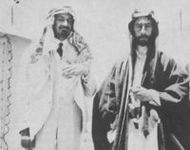
. . . . . . . . . . . . . . . . . . . . . . . . . . . . . . . . . . . . . . . . . . . . . . . . . . . . . . . . . . . . . . . . . . . . . . . . . . . . . . . . . . . . . . . . . . . . . . . . . . . . . . . . . . . . . . . . . . . . . . . . . . . . . . . . . . . . . . . . . . . . . . . . . . . . . . . . . . . . . . . . . . . . . . . .
التعاقب
| مناصب سياسية | ||
|---|---|---|
| سبقه ديڤيد بن گوريون |
Chairman of the Provisional State Council 17 مايو, 1948 - 17 فبراير, 1949 |
تبعه لم يعد موجوداً |
| سبقه لقب مستحدث |
رئيس إسرائيل 1 فبراير, 1949 - 9 نوفمبر 1952 |
تبعه Yitzhak Ben-Zvi |
- ^ Chaim Weizmann Of Israel Is Dead Archived 25 أكتوبر 2017 at the Wayback Machine
- ^ Brown, George Ingham (1998) The Big Bang: A History of Explosives, Sutton Publishing ISBN 0-7509-1878-0 p. 144
- ^ أ ب ت "Biography | chaimweizmann". Archived from the original on 25 October 2017. Retrieved 25 October 2017.
- ^ أ ب "Short life history: Chaim Weizmann". Archived from the original on 11 March 2016. Retrieved 27 October 2017.
- ^ Geoffrey Lewis, Balfour and Weizmann: The Zionist, the Zealot and the Emergence of Israel, A & C Black, 2009
- ^ أ ب Rose, Norman (1986). Chaim Weizmann: A Biography. New York, New York: Viking Penguin, Inc. pp. 55–56. ISBN 0-670-80469-X.
- ^ Hirsch, Luise (2013). From the Shtetl to the Lecture Hall: Jewish Women and Cultural Exchange. Lanham, Maryland: University Press of America. p. 59. ISBN 978-0-7618-5993-2.
- ^ أ ب ت ث ج "10 things we didn't know about Dr. Chaim Weizmann" (PDF). The Weizmann International Magazine of Science & People. 3. Spring 2013. Archived (PDF) from the original on 2 April 2015. Retrieved 18 March 2015.
- ^ Family Trials Archived 28 مايو 2015 at the Wayback Machine
- ^ Roman Brackman, Israel at High Noon: From Stalin's Failed Satellite to the Challenge of Iran, Enigma Books, 2006 ISBN 978-1-929-63164-3 p. 113.
- ^ Anderson, Scott (2013). Lawrence in Arabia: War, Deceit, Imperial Folly and the Making of the Modern Middle East. United States: Knopf Doubleday Publishing Group. pp. 128–129. ISBN 9780385532938.
- ^ "Jewish Women Encyclopedia, Vera Weizmann". Jwa.org. Archived from the original on 13 August 2012. Retrieved 8 June 2012.
- ^ Casualty Details Archived 16 فبراير 2018 at the Wayback Machine Commonwealth War Graves Commission
- ^ "Flight Lieutenant Michael Oser Weizmann | War Casualty Details 1531206". Archived from the original on 17 February 2015. Retrieved 18 March 2015.
- ^ Yechiel Weizman Another Brother of Dr. Weizman, Dies in Israel Archived 28 مايو 2015 at the Wayback Machine
- ^ Orme, William A. Jr.; Myre, Greg (25 April 2005). "Ezer Weizman, Former President of Israel and Hero of 1967 War, Dies at 80". The New York Times (in الإنجليزية الأمريكية). ISSN 0362-4331. Archived from the original on 8 December 2017. Retrieved 8 December 2017.
- ^ Biography of Chaim Weizmann Archived 3 فبراير 2014 at the Wayback Machine
- ^ أ ب "Biography of Chaim Weizmann". Zionism-israel.com. Archived from the original on 4 May 2012. Retrieved 8 June 2012.
- ^ Ayache, Georges (2019). Les douze piliers d'Israël. Paris. p. 57. ISBN 978-2-262-07259-9. OCLC 1104137945.
{{cite book}}: CS1 maint: location missing publisher (link) - ^ Gilbert, Martin (2007). Churchill and the Jews: a lifelong friendship. New York: Henry Holt. p. 324. ISBN 9781466829626.
- ^ Weizmann Reveals Truman Promised Negev to Jews; Surrenders His British Citizenship Archived 20 فبراير 2014 at the Wayback Machine
- ^ Glenda Abramson, ed. (2005). Encyclopedia of Modern Jewish Culture. Routledge. p. 950. ISBN 9780415298131. Archived from the original on 16 February 2018. Retrieved 18 March 2015.
As a research chemist, he registered some 100 patents under the name Charles Weizmann.
- ^ Schellenberg, Walter (2001) Invasion, 1940: The Nazi Invasion Plan for Britain, p. 260. Little Brown Book Group. ISBN 0-9536151-3-8. Accessed at the Imperial War Museum
- ^ Local Industry Owes Much to Weizmann Archived 25 مايو 2013 at the Wayback Machine
- ^ Zalloum, Abdulhay Y. (2011). America in Islamistan: Trade, Oil and Blood. Trafford Publishing. ISBN 9781426927928. Archived from the original on 12 November 2017.
- ^ as reported by C.P.Scott in Wilson, pp. 333–334
- ^ Wilson, Scott's Diaries, p. 369
- ^ "Chaim Weizmann Lab, Dept. of Organic Chemistry". Weizmann Institute. Archived from the original on 11 May 2007.
- ^ "About the Institute". Weizmann Institute of Science (in الإنجليزية). Archived from the original on 4 July 2017. Retrieved 15 February 2018.
- ^ Witschi, H (2000). "Fritz Haber: 1868-1934". Toxicological Sciences. 55 (1): 1–2. doi:10.1093/toxsci/55.1.1. PMID 10788553.
- ^ "Faculty of Chemistry | History". Weizmann Institute of Science (in الإنجليزية). 23 June 2014. Archived from the original on 12 August 2017. Retrieved 15 February 2018.
- ^ "Chaim Weizmann – Biography". University of Fribourg Department of Chemistry. Archived from the original on 16 July 2015. Retrieved 15 February 2018.

